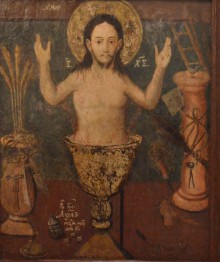Unfortunately, nobody knows which of the temples this icon adorned, for it was kept in the repositories of the Volyn Museum of Local History without any notice of its origin. But it is known to have been brought here a very long time ago. The icon bears the exact date of being painted: “March 26, the Year of Our Lord 1737.”
The exhibited icon was restored at the National Research and Restoration Center of Ukraine by Olha Frolova. It has an interesting composition that represents Eucharist as the Body and Blood of Christ. The icon is full of symbolic images which show Jesus Christ’s last days of earthly existence, his sufferings and death. The center of the composition is a below-the-waist picture of Christ in a silver chalice with elbow-bent raised arms. Blood trickles from his eyes, wounds on the hands, and from under a rib. The chalice symbolizes not only a church vessel used during the Eucharist, a cup which Christ handed over to his disciples during the Last Supper, but also the Holy Grail (the cup into which Jesus’ blood was gathered).
To the right of Christ, the icon painter depicted a vase with wheat ears as symbol of communion with bread which symbolizes the body of Jesus. The rooster is the symbol of Peter’s repudiation of Christ. The blooded hand is the symbol of Judas’ treachery, while the sword reminds us of Apostle Peter cutting off the ear of the high priest’s slave Malchus, when Christ was being arrested in Gethsemane. The lantern and the torch are an illustration to the text of the Gospel according to St. John: “Judas then, having received a band of men and officers from the chief priests and Pharisees, cometh thither with lanterns and torches…” The basin and the pitcher may also symbolize the washing of the apostles’ feet by Christ during the Last Supper and the washing of hands by Pontius Pilate.
By Western tradition, the icon painter depicted the Veil of Veronica. Church legend has it that, as Christ was on his way to Calvary, Veronica gave Him her veil to wipe sweat and blood off His face. The instruments of Passions on the cross are represented by nails, a hammer, a lance, and a cane. The artist also painted the tongs with which nails were pulled out from Jesus’ hands, the ladder by means of which the dead body of Christ was taken down from the cross, and the dice which the soldiers used to play off the clothes.
The icons Christ in the Chalice, which were supposed to express self-sacrificingness of the Son of God for the sake of the salvation of people, are among the most interesting acquisitions of the Museum of the Volhynian Icon.








